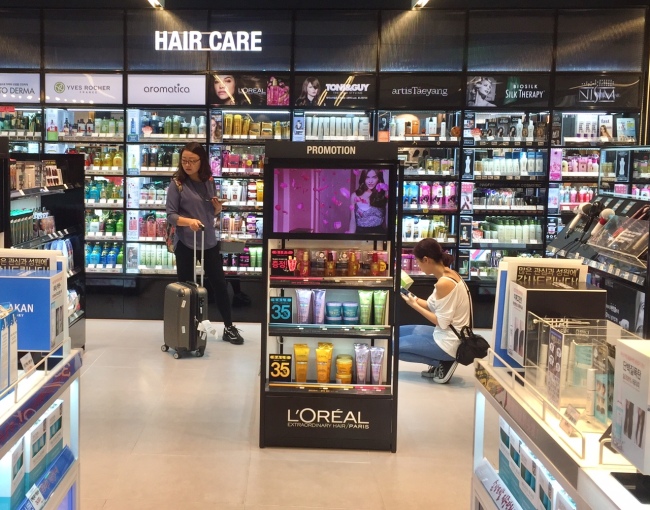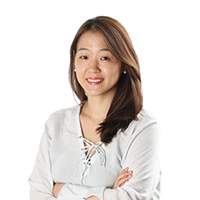Walking up to the second floor of one of the biggest branches of a leading health and cosmetics chain, Olive Young, what catches your eye is the hair products section.
The size of the section -- with products ranging from dozens of shampoo brands to anti-aging hair products and small gadgets like hair irons -- reflects the importance of hair products in the beauty industry.
The size of the section -- with products ranging from dozens of shampoo brands to anti-aging hair products and small gadgets like hair irons -- reflects the importance of hair products in the beauty industry.

Hair care products accounted for more than 13 percent of the total production by Korean cosmetics companies in 2015, totaling 1.4 trillion won, according to data from the Korea Cosmetic Association. Production has been growing at an average 13.9 percent a year since 2011.
Hair care has become almost as important as skin care in the eyes of consumers, and companies are catching on.
Blemish balm, overnight masks and sun care products -- all of which are popular facial care items -- have seen their hair care counterparts make their debuts recently.
Just eight years ago, hair product sales were half of what they are now, with an average family of four sharing the same shampoo and conditioner.
Now each member of this average family has their own shampoo.
The father, for example, may be more concerned with hair loss, while his wife worries about her graying hair. The son might be dealing with dandruff and his sister wants hair products that lack the controversial chemicals that have been in the news over the last few years.
Manufacturers are now targeting these particular consumer demands.
Companies like AmorePacific and LG Life Science, which together occupy more than 50 percent of the domestic market, have been busy introducing a long chain of new products in order to meet this demand.
According to CJ OliveNetworks, which runs 650 Olive Young chain stores around the country, hair care sales have grown of 45 percent in the first 9 months this year, backed by a strong 60 percent increase in sales of products containing fewer chemical additives and hypoallergenic hair products.
Concerns about hair loss have long been a force in the market. Since the mid-2000s, the most popular option was shampoos with Korean traditional medicine, as customers believed that these products could do something regular shampoos couldn’t -- prevent balding.
“The news reports about some chemicals used in shampoo made me terrified,” Park Su-yeon, a graduate student in her late 20s, said. “It can cause hair loss and that’s the last thing I need.”
A businessman surnamed Kim in his 40s said: “When I was watching a TV home shopping channel few years ago, they were selling this shampoo with Korean traditional medicine, saying that it would stop hair loss. … It is more expensive than regular shampoos, but my hair is more important than money.”
According to the National Health Insurance Service, a total of 207,900 Koreans received hair loss-related treatment in 2015 and the actual number of people experiencing hair loss is estimated to be as high as 10 million.
Backed by the success of shampoos with anti-hair loss claims in the domestic market, South Korean companies have begun selling anti-hair loss-related products overseas.
Shampoo brands Ryo by AmorePacific and Rien by LG are sold at higher prices in countries like China, Thailand, Russia and Singapore.
The hair care industry has also seen an uptick in demand for home care products such as styling devices or home treatment kits. According to Olive Young, sales for home hair care products doubled over a year ago.
Shin, a school teacher in her 50s, uses a curling iron almost every day and has to dye her hair every few weeks to cover up her gray hair. Shin is also interested in home hair treatment to help protect her hair from the frequent coloring and heat treatments she does.
“Going to salons for hair coloring or perming cost too much money,” said Shin. “So many choices are available anyway and they are as good as going to hair salons.”
These days men are becoming more familiar with hair care products. A 35-year man with a dandruff problem surnamed Lee bought an electric scalp massager.
Younger men like him also spend more than previous generations on products like styling gels.
While consumers are surrounded by numerous product lines and vast choices, hair salons are also set to cash in consumers’ desire for healthy and voluminous hair, with help of the country’s tech giant Kakao.
Kakao rolled out its Kakao Hairshop service in July. The salon booking service aims to solve various industry problems such as “no show” clients.
By Park Ga-young (gypark@heraldcorp.com)

















![[KH Explains] Hyundai's full hybrid edge to pay off amid slow transition to pure EVs](http://res.heraldm.com/phpwas/restmb_idxmake.php?idx=652&simg=/content/image/2024/04/18/20240418050645_0.jpg&u=20240419100350)

![[Today’s K-pop] Zico drops snippet of collaboration with Jennie](http://res.heraldm.com/phpwas/restmb_idxmake.php?idx=642&simg=/content/image/2024/04/18/20240418050702_0.jpg&u=)